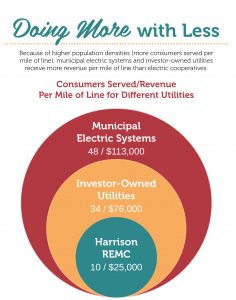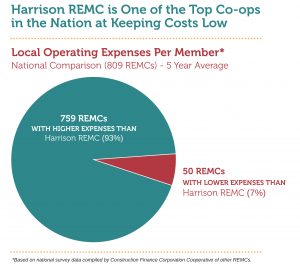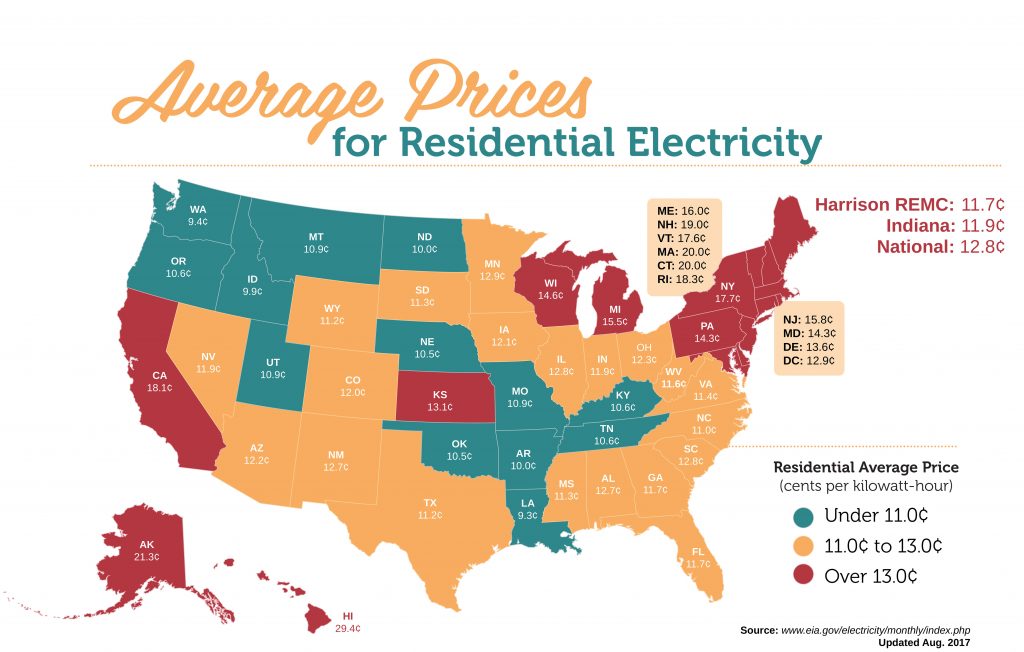 Harrison REMC’s employees and directors work to keep your local cooperative in sound condition. Management and the REMC board consider the needs and expectations of the membership (reliable service at a reasonable price) while ensuring a skilled workforce is equipped with the necessary tools to perform duties in a safe and efficient manner.
Harrison REMC’s employees and directors work to keep your local cooperative in sound condition. Management and the REMC board consider the needs and expectations of the membership (reliable service at a reasonable price) while ensuring a skilled workforce is equipped with the necessary tools to perform duties in a safe and efficient manner.
This past spring, the REMC conducted a cost-of-service study that indicated the cooperative needed to increase rates. At the August board meeting, the board approved the 1.5 percent increase in rates to cover local distribution expenses. This small rate adjustment will be the first rate increase in more than three years. It will be effective with November 2017 bills. For a typical REMC residential member averaging 1,400 kWh per month, the increase will result in an additional monthly charge of $2.18. This local increase likely will keep distribution rates stable for the next two years.
The REMC’s employees and board members work hard to keep rates as low as possible while striving to maintain reliability at a level that meets member expectations. As you can see from the chart on the lower right of the next page, your local cooperative is one of the top co-ops in the nation at keeping local operating costs low. In fact, over the past five years, Harrison REMC has outperformed 93 percent of the 809 measured cooperatives across the nation in managing local operating costs.
Since the REMC operates on a not-for-profit basis, these low operating costs translate into lower electric rates. As shown in the chart on the top of the next page, our rates are lower than the state average and national average when compared to all electric utility companies. Now consider the fact that electric cooperatives provide service to more rural areas of the country than investor-owned utilities and municipals do. When a cooperative like Harrison REMC (10 members per mile of line) can provide rates equal to or lower than investor-owned utilities (34 customers per mile of line), and municipal-owned utilities (48 customers per mile of line) at any use level, you can be assured that the local cooperative not-for-profit model is working for you.
 Given that we are a local utility with employees and a member-elected board from your community, we share your interests and concerns. We’re able to provide reasonable rates compared with investor-owned and municipal utilities because of our local focus. We are not looking to raise rates to meet the needs of stockholders located throughout the world.
Given that we are a local utility with employees and a member-elected board from your community, we share your interests and concerns. We’re able to provide reasonable rates compared with investor-owned and municipal utilities because of our local focus. We are not looking to raise rates to meet the needs of stockholders located throughout the world.
When comparing the electric rates of other cooperatives in Indiana, the efforts of the employees and board to limit our local distribution costs have proved effective. Our residential rates were the third lowest among the 36 electric cooperatives in the state for an all-electric home.
This rate increase will be accomplished by raising the basic service charge $2.50 for a residential account while slightly lowering the cost billed per kWh.
The cost-of-service study mentioned above indicates a basic service charge of $43.31 is needed to cover the actual fixed cost incurred by the REMC. Our current basic service charge of $20 per month is the lowest in the state based on a recent state survey. With the increase of $2.50, Harrison REMC will still have the lowest basic service charge in the state. The current state average is $29 per month, and the highest is $44 per month.
A basic service charge is needed to help cover the cost and maintenance of the infrastructure (poles, transformers, wire, etc.) to provide power to your location, regardless of whether you use the power provided. These costs are incurred by the REMC each month to establish service and make power available 24 hours a day, seven days a week.
We appreciate your comments and suggestions throughout the year and will continue to work hard to keep costs minimized, while offering reliable electric power and services that meet the needs of our members.




